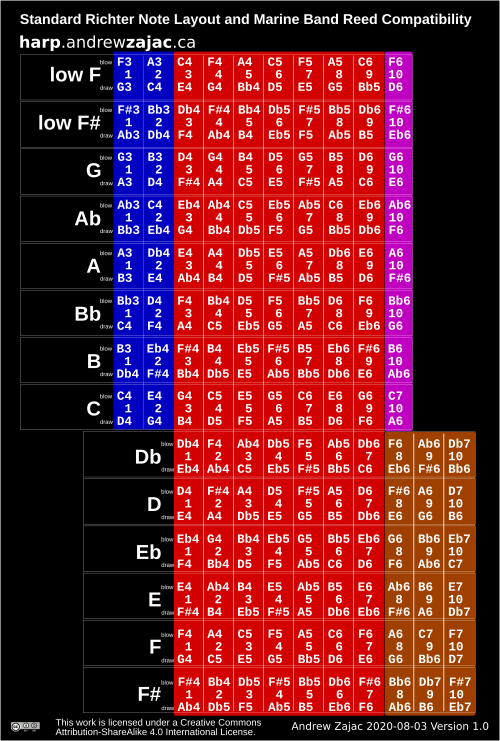Harmonicas in the Hohner Marine Band family - and that includes Marine Band 1896, Marine Band Deluxe, Marine Band Crossover, Marine Band Thunderbird, Special 20, Rocket and Golden Melody - all use the same kind of reeds.
Reeds can be replaced when they "blow out" or go flat. Hohner sells individual reeds but shipping costs may be quite high.
The good news is that you can scavenge a reed from one harmonica and put it into another just as long as they have the same slot dimensions. Players have been doing this for decades.
Unlike other manufacturers, Hohner makes two configurations of their reeds, one for lower keys ('Long slot" up to the key of C) and one for higher keys ("Short slot" starting at the key of Db and going up).
The slot dimensions line up for most of the reeds.
That means when looking for a replacement reed, you often have more options than you think. You might be able to find the reed you need on two, three or even four other reed plates!
Here's a chart of the reeds organised by slot dimension.
It's also a table of all of the notes of Standard Richter tuning in every key with the octaves displayed - I find this handy when I'm tuning a harmonica and a reed is so far out of tune it's playing the wrong note. I can use this table to quickly look up what the pitch should be.

(Right-click on the image to download the low-resolution version of this chart for free.)
 Find the reed you are looking for in the chart. Stay in the same column and look for a reed with the same pitch (or within one or two semitones if you are comfortable with tuning a reed up or down by two semitones. Try to get a reed that's as close to the pitch you need.)
Find the reed you are looking for in the chart. Stay in the same column and look for a reed with the same pitch (or within one or two semitones if you are comfortable with tuning a reed up or down by two semitones. Try to get a reed that's as close to the pitch you need.)
Example: I need a 4 draw reed for a D harp. The pitch is E5. Within the same column, I can find the exact same reed on:
-a G harp, 6 draw
-an A harp, 6 blow
or
-an E harp, 4 blow
Remember to stay within the same column.
The highest slot (the ten hole) on Long slot reed plates have different dimensions than the eighth slot on Short slot reed plates. They are separated on the chart.
Some notes of the scale have different names - C# is the same note as Db and G# is the same note as Ab. If this were a table of scale degrees, I would respect the proper names. But since this chart is built for speed and simplicity, I've picked the most commonly used names of the notes. I've only used one name for the enharmonic notes.
Use this chart to help plan out altered tunings. I find it helpful when the altered tuning goes beyond three octaves. You will find that it's often more advantageous to start with a high key (short slot reed plate) and tune the low end downwards rather than start with a low key and tune the high reed up. You often have more options when you start with a short slot set of plates.
Save and use the chart displayed on this page for free. Right-click on it and save it to your computer or phone.
I am offering a higher resolution version as PDF files. There is a color one as well as a black and white version.
I can also send you a printed version in high resolution on coated 100 lb stock which is perfect for hanging on your wall by your workbench at eye level for quick reference.
Purchase printed version page.
How do you replace a reed? You can do it! Take a look at my Reed Replacement Kit.
